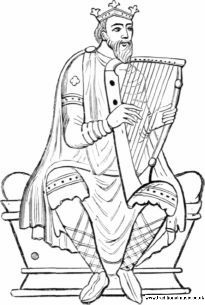MUSICAL INSTRUMENTS - online book
The History And Development Of Musical Instruments From The Earliest Times.
| Share page | Visit Us On FB |
|
MUSICAL IXSTRUMEXTS. |
H<) |
||
|
in almost every century. The psalterium, or psalterion (Italian salterio, English psaltery), of the fourteenth century and later had the trapezium shape of the dulcimer.
The Anglo-saxons frequently accompanied their vocal effusions with a harp, more or less triangular in shaoe,—an instrument which may be considered rather as constituting the transition of the lyre into the harp. The representation of king David playing the harp is from an Anglo-saxon manuscript of the beginning of the eleventh century, in the British museum. The harp was especially popular in central and northern Europe, and was the favourite instrument of the German and Celtic bards and of the Scandinavian skalds. In the next illustration from the manuscript of the monastery of St. Blasius twelve strings and two sound holes are given to it. A harp similar in form and size, but without the front pillar, was known to the ancient Egyptians. Perhaps the addition was also non-existant in the earliest specimens appertaining to European nations ; and a sculptured figure of a small harp constructed like the ancient eastern harp has been discovered in the old church of Ullard in the county of Kilkenny. Of this curious relic, which is said to date from a period anterior to the year 800, a fac-simile taken from Bunting's " Ancient Music of Ireland" is given (p. 91). As Bunting
 |
|||